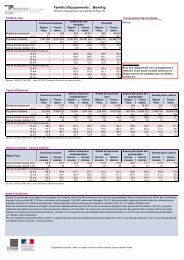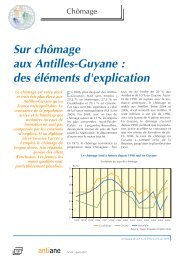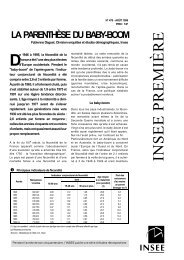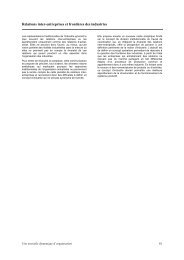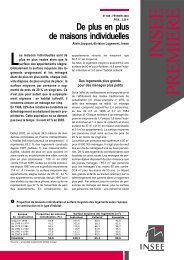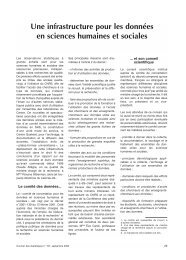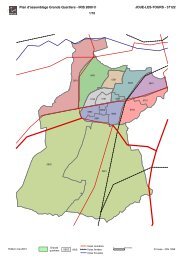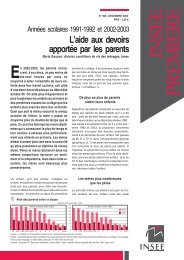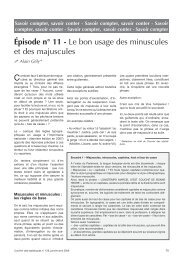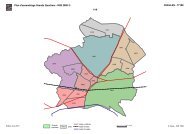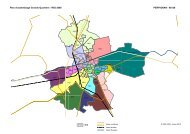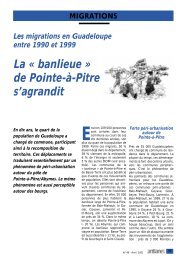Les salaires sont-ils rigides ? Le cas de la France à la fin des ... - Insee
Les salaires sont-ils rigides ? Le cas de la France à la fin des ... - Insee
Les salaires sont-ils rigides ? Le cas de la France à la fin des ... - Insee
You also want an ePaper? Increase the reach of your titles
YUMPU automatically turns print PDFs into web optimized ePapers that Google loves.
BIBLIOGRAPHIE<br />
Akerlof G., Dickens W. et Perry G. (1996), « The<br />
Macroeconomics of Low Inf<strong>la</strong>tion », Brookings<br />
Papers on Economic Activity, n° 1, pp. 1-59.<br />
Altonji J.G. et Devereux P.J. (2000), « Extent<br />
and Consequences of Downward Nominal Wage<br />
Rigidity », in Po<strong>la</strong>chek S.W., Worker Well-Being,<br />
Research in Labor Economics, vol. 19, pp. 383-<br />
431, Elsevier Science, North Hol<strong>la</strong>nd, Amsterdam.<br />
Beissinger T. et Knoppik C. (2003), « How Rigid<br />
are Nominal Wages? Evi<strong>de</strong>nce and Implication for<br />
Germany », Scandinavian Journal of Economics,<br />
vol. 105, n° 4, pp. 619-641.<br />
Bewley T.F. (1999), Why Wages Don’t Fall During a<br />
Recession, Harvard University Press, Cambridge.<br />
Bonnet X., Dubois É., Goux D., Schnei<strong>de</strong>r J.-L.<br />
et Martin E. (1997), « Inf<strong>la</strong>tion faible et rigidité <strong>à</strong><br />
<strong>la</strong> baisse <strong>de</strong>s <strong>sa<strong>la</strong>ires</strong> nominaux », dans L’Économie<br />
Française 1997-1998, <strong>Insee</strong>, Hachette, <strong>Le</strong> Livre<br />
<strong>de</strong> Poche, pp. 135-160.<br />
Bound J., Brown C. et Mathiowetz N. (2001),<br />
« Measurement Error in Survey Data », Handbook<br />
of Econometrics, vol. 5, chapitre 59, pp. 3705-<br />
3843, E.E. <strong>Le</strong>arner et J.J. Heckman éds., Elsevier<br />
Science, North Hol<strong>la</strong>nd, Amsterdam.<br />
Bound J. et Krueger A. (1991), « The Extent<br />
of Measurement Error in Longitudinal Earnings<br />
Data: Do Two Wrongs Make a Right? », Journal<br />
of Labor Economics, vol. 9, n° 1, pp. 1-24.<br />
Brizard A. (2000), « La rémunération <strong>de</strong>s sa<strong>la</strong>riés<br />
en 1998 », Premières informations et premières<br />
synthèses, n° 01.1, Dares.<br />
Card D. et Hyslop D. (1997), « Does Inf<strong>la</strong>tion<br />
“Grease the Wheels” of Labor Market? », dans<br />
Reducing inf<strong>la</strong>tion : motivation and strategy, C.D,<br />
Romer et H.D, Romer éditeurs, n° 356, chapitre 2,<br />
pp. 71-114, University of Chicago Press, Chicago,<br />
IL and London.<br />
Fehr E. et Goette L. (2005), « Robustness and<br />
Real Consequences of Nominal Wage Rigidity »,<br />
Journal of Monetary Economics, vol. 52, n° 4,<br />
pp. 779-804.<br />
Hagnéré C. et <strong>Le</strong>franc A. (2002), « Étendue et<br />
conséquence <strong>de</strong>s erreurs <strong>de</strong> mesure dans les données<br />
d’enquête », miméo, présenté aux Journées<br />
<strong>de</strong> méthodologie statistique <strong>de</strong> l’<strong>Insee</strong>.<br />
Hol<strong>de</strong>n S. (1999), « Renegotiation and the<br />
Efficiency of Investment », Rand Journal of<br />
Economics, vol. 30, n° 1, pp. 106-119.<br />
Kahn S. (1997), « Evi<strong>de</strong>nce of Nominal Wage<br />
Stickiness from Microdata », American Economic<br />
Review, vol. 87, n° 5, pp. 993-1008.<br />
Keynes (1936), Théorie générale <strong>de</strong> l’emploi, <strong>de</strong><br />
l’intérêt et <strong>de</strong> <strong>la</strong> monnaie, traduction <strong>de</strong> Jean <strong>de</strong><br />
Largentaye, petite bibliothèque Payot.<br />
Mac<strong>Le</strong>od B. et Malcomson J. (1993),<br />
« Investments, Hold-Up and the Form of Market<br />
Contracts », American Economic Review, vol. 83,<br />
n° 4, pp. 811-837.<br />
McLaughlin K. (1994), « Rigid Wages? »,<br />
Journal of Monetary Economics, vol. 34, n° 3,<br />
pp. 383-414.<br />
Mund<strong>la</strong>k Y. (1978), « On the Pooling of Time<br />
Series and Cross Sectional Data », Econometrica,<br />
vol. 46, n° 1, pp. 69-85.<br />
Nickell S. et Quintini G. (2003), « Nominal<br />
wage rigidity and the rate of inf<strong>la</strong>tion », Economic<br />
Journal, vol. 113, n° 490, pp. 762-781.<br />
Pischke J.S. (1995), « Measurement Error and<br />
Earnings Dynamics: Some Estimates From the<br />
PSID Validation Study », Journal of Business and<br />
Economics Statistics, vol. 13, n° 3, pp. 305-314.<br />
Seguin S. (2005), « La rémunération <strong>de</strong>s sa<strong>la</strong>riés<br />
<strong>de</strong>s entreprises en 2003 », Premières Informations<br />
et Premières Synthèses, n° 12.3, Dares.<br />
Smith, J. (2000), « Nominal Wage Rigidity in<br />
the United Kingdom », The Economic Journal,<br />
vol. 110, n° 462, pp. C176-C195.<br />
Tobin J. (1972), « Inf<strong>la</strong>tion and Unemployment »,<br />
American Economic Review, vol. 62, n° 1-2,<br />
pp. 1-18.<br />
ÉCONOMIE ET STATISTIQUE N° 386, 2005 73



